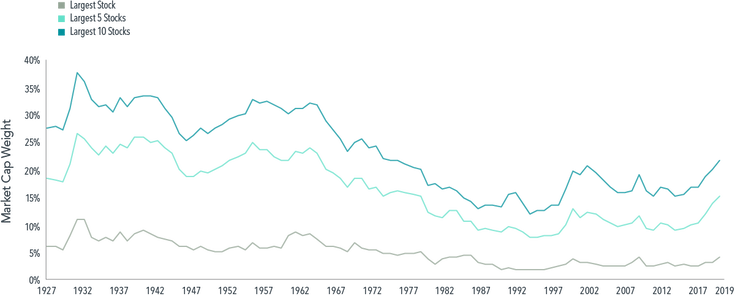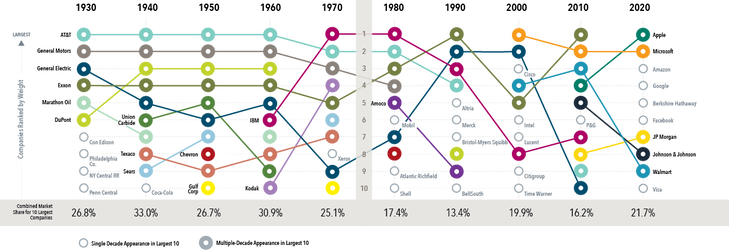|
A top-heavy stock market with the largest 10 stocks accounting for over 20% of market capitalization and a marquee technology firm perched at No. 1? This sounds like a description of the current US stock market, dominated by Apple and the other FAANG stocks,1 but it is actually a reference to 1967, when IBM represented a larger portion of the market than Apple at the end of 2019 (5.8% vs. 4.1%). As we see in Exhibit 1, it is not particularly unusual for the market to be concentrated in a handful of stocks. The combined market capitalization weight of the 10 largest stocks, just over 20% at the end of last year, has been higher in the past. Exhibit 1 Same Old Story Weight of largest stocks by market capitalization in US stock market, 1927–2019 A breakdown of the largest US stocks by decade in Exhibit 2 shows some companies have stayed on top for a long time. AT&T was among the largest two for six straight decades beginning in 1930. General Motors and General Electric ranked in the top 10 at the start of multiple decades. IBM and Exxon were also mainstays in the second half of the 20th century. Hence, concentration of the stock market in a few large companies such as the FAANG stocks in recent years is not a new normal; it is old normal. Exhibit 2 Big Board Largest 10 US stocks at the start of each decade Moreover, while the definition of “high-tech” is constantly evolving, firms dominating the market have often been on the cutting edge of technology. AT&T offered the first mobile telephone service in 1946. General Motors pioneered such innovations as the electric car starter, airbags, and the automatic transmission. General Electric built upon the original Edison light bulb invention, contributing to further breakthroughs in lighting technology, such as the fluorescent bulb, halogen bulb, and the LED. So technological innovation dominating the stock market is not a new normal; it is an old normal too. Another trend attributed to a new normal is the extraordinary performance of FAANG stocks over the past decade, leading some to wonder if we should expect these stocks to continue such strong performance going forward. Investors should remember that any expectations about the future operational performance of a firm are already reflected in its current price. While positive developments for the company that exceed current expectations may lead to further appreciation of its stock price, those unexpected changes are not predictable. To this point, charting the performance of stocks following the year they joined the list of the 10 largest firms shows decidedly less stratospheric results. On average, these stocks outperformed the market by an annualized 0.7% in the subsequent three-year period. Over five- and 10-year periods, these stocks underperformed the market on average. Exhibit 3 Power Down Annualized return in excess of market for stocks after joining list of 10 largest US stocks, 1927–2019 The only constant is change, and the more things change the more they stay the same. This seems an apt description of the dominant stocks atop the market. While the types of businesses most prominent in the market vary through time, the fact that a small subset of companies’ stocks account for an outsized portion of the stock market is not new. And it remains impossible to systematically predict which large companies will outperform the stock market and which will underperform it. This underscores the importance of having a broadly diversified equity portfolio that provides exposure to a vast array of companies and sectors. GLOSSARY
1. Facebook, Amazon, Apple, Netflix, and Google (a subsidiary of Alphabet) are often referred to as the FAANG stocks. Fama/French Total US Market Research Index: The value-weighed US market index is constructed every month, using all issues listed on the NYSE, AMEX, or Nasdaq with available outstanding shares and valid prices for that month and the month before. Exclusions: American depositary receipts. Sources: CRSP for value-weighted US market return. Rebalancing: Monthly. Dividends: Reinvested in the paying company until the portfolio is rebalanced. The information in this document is provided in good faith without any warranty and is intended for the recipient’s background information only. It does not constitute investment advice, recommendation, or an offer of any services or products for sale and is not intended to provide a sufficient basis on which to make an investment decision. It is the responsibility of any persons wishing to make a purchase to inform themselves of and observe all applicable laws and regulations. Unauthorized copying, reproducing, duplicating, or transmitting of this document are strictly prohibited. Dimensional accepts no responsibility for loss arising from the use of the information contained herein. “Dimensional” refers to the Dimensional separate but affiliated entities generally, rather than to one particular entity. These entities are Dimensional Fund Advisors LP, Dimensional Fund Advisors Ltd., Dimensional Ireland Limited, DFA Australia Limited, Dimensional Fund Advisors Canada ULC, Dimensional Fund Advisors Pte. Ltd, Dimensional Japan Ltd., and Dimensional Hong Kong Limited. Dimensional Hong Kong Limited is licensed by the Securities and Futures Commission to conduct Type 1 (dealing in securities) regulated activities only and does not provide asset management services. Dimensional Fund Advisors LP is an investment advisor registered with the Securities and Exchange Commission. Same Old Story, Big Board, Power Down Charts Source: Dimensional, using data from CRSP and Compustat. Includes all US common stocks. Largest stocks identified at the end of each calendar year by sorting stocks on market capitalization. CRSP and Compustat data provided by the Center for Research in Security Prices, University of Chicago. Market is represented by the Fama/French Total US Market Research Index. Excess return for each stock is the difference in annualized compound returns between the stock and the market, computed from the first month following initial classification in the top 10. Stocks in the sample are required to have at least 36 months of returns data following classification in the top 10. Do you find it puzzling when a bleak economic report emerges from the press, only to be accompanied by a positive surge in the stock market? You’re not alone. The last few weeks have produced many examples of a stark contrast between stock market performance and economic indicators. So why the apparent disconnect? Markets are forward-looking, meaning current asset prices reflect market participants’ aggregate expectations. Those expectations include whatever future economic developments are anticipated and their potential impact on cash flows, which are key to a stock’s value. For example, if the market expects the economic environment to weaken company cash flows, stock markets may react well in advance of when we observe the impact on cash flows, as expectations are embedded in prices. And the eventual direction of the stock market will depend on how the economic outcome compares to expectations. If things aren’t as bad as expected, poor economic news can be greeted with a positive stock reaction. Looking Ahead We can see this anticipatory nature of markets in action by looking at the relation between US gross domestic product (GDP) growth and equity premiums, or stock market returns in excess of one-month US Treasury bills. When annual US equity premiums are plotted against GDP growth for the same year (top panel of Exhibit 1), there is no discernable relation between the two. Changes in GDP have not been strongly related to simultaneous stock market returns. It’s important to note that this result does not imply financial markets ignore macroeconomic data. After all, GDP encompasses several measures of the economy, not just corporate profits. However, while GDP may be an imprecise representation of the activities that ultimately drive stock prices, further analysis shows that is not the sole cause for the lack of relation between GDP growth and simultaneous equity premiums. Plotting GDP growth against the previous year’s equity premium (bottom panel of Exhibit 1) reveals a noticeable relation. The positive trend in the data suggests market prices have in fact reacted to changes in GDP but have done so in advance of these economic developments coming to fruition. This result is consistent with markets pricing in their expectation of economic growth. Exhibit 1 - Plot Development US equity premium vs. GDP growth, 1930-2019 That brings us to the latest news headline worrying some investors: the eventual fallout from increasingly large US government expenditures designed to ease the economic burden of the COVID-19 pandemic. Will these efforts ultimately create a financial burden for the US government that affects future stock returns? The results in Exhibit 2 should help allay concerns over the debt level impacting equity market performance. When we sort countries each year on their debt-to-GDP for the prior year (top panel), average annual equity premiums have been slightly higher for high-debt countries than low-debt countries in both developed and emerging markets. However, the return differences’ small t-statistics—a measure of the precision of a value’s estimate – suggest these averages are not reliably different from one another.1 The top panel uses prior year debt-to-GDP data to sort countries into the high/low groups. But investors may be more focused on where they expect the debt to end up, rather than on where it’s been. In the bottom panel of Exhibit 2, we rank countries on debt-to-GDP at the end of the current year, assuming perfect foresight of end-of-year debt levels. Again, average equity premiums have been similar for high- and low-debt countries. Like the results for GDP growth, these results imply that markets have generally priced in expectations for future government debt. Exhibit 2 - Debt Defying Average equity premiums for countries sorted on debt MARKETS AT WORK Macroeconomic variables and investment decisions are like frozen turkeys and deep fryers—caution should be exercised when combining the two. The results presented here are consistent with markets aggregating and processing vast sets of macroeconomic indicators and expectations for those indicators. By incorporating this information into market prices, we believe public capital markets effectively become the best available leading macroeconomic indicator. All data is from sources believed to be reliable but cannot be guaranteed or warranted. This information is intended for educational purposes, and it is not to be construed as an offer, solicitation, recommendation, or endorsement of any particular security, products, or services. No one should assume that any discussion or information contained in this material serves as a receipt of, or as a substitute for, personalized investment, tax or legal advice. Diversification does not eliminate the risk of market loss. Investment risks include loss of principal and fluctuating value. Past performance is not a guarantee of future results. Indices are not available for direct investment; therefore, their performance does not reflect the expenses associated with the management of an actual portfolio.
Appendix When Stocks and the Economy Diverge Past performance is not a guarantee of future results. Annual GDP growth rates obtained from the US Bureau of Economic Analysis. GDP growth numbers are adjusted to 2012 USD terms to remove the effects of inflation. Annual US equity premium is return difference between the Fama/French Total US Market Research Index and One-Month US Treasury Bill. Equity premium data provided by Ken French, available at mba.tuck.dartmouth.edu/pages/faculty/ken.french/data_library.html. Eugene Fama and Ken French are members of the Board of Directors of the general partner of, and provide consulting services to, Dimensional Fund Advisors LP. “One-Month Treasury Bills” is the IA SBBI US 30 Day TBill TR USD, provided by Ibbotson Associates via Morningstar Direct. All returns in USD. Countries are sorted at the beginning of each year. High-Debt and Low-Debt refer to countries above and below the median debt, respectively. Debt is general government debt and central government debt. Source: The International Monetary Fund. Equity market returns represented by MSCI country indices. Dimensional calculations from Bloomberg and MSCI data. Indices are not available for direct investment; therefore, their performance does not reflect the expenses associated with the management of an actual portfolio. 1. Researchers often cite a t-statistic value of 2.0 as the threshold for statistical reliability. GLOSSARY Macroeconomic data: Data used to measure the output of an economy, such as employment or production. Gross domestic product: The total value of goods and services produced by, for example, a country over a set period of time. Debt-to-GDP: The ratio of a company’s debt to its gross domestic product. Fama/French Total US Market Research Index: The value-weighed US market index is constructed every month, using all issues listed on the NYSE, AMEX, or Nasdaq with available outstanding shares and valid prices for that month and the month before. Exclusions: American depositary receipts. Sources: CRSP for value-weighted US market return. Rebalancing: Monthly. Dividends: Reinvested in the paying company until the portfolio is rebalanced. The information in this document is provided in good faith without any warranty and is intended for the recipient’s background information only. It does not constitute investment advice, recommendation, or an offer of any services or products for sale and is not intended to provide a sufficient basis on which to make an investment decision. It is the responsibility of any persons wishing to make a purchase to inform themselves of and observe all applicable laws and regulations. Unauthorized copying, reproducing, duplicating, or transmitting of this document are strictly prohibited. Dimensional accepts no responsibility for loss arising from the use of the information contained herein. “Dimensional” refers to the Dimensional separate but affiliated entities generally, rather than to one particular entity. These entities are Dimensional Fund Advisors LP, Dimensional Fund Advisors Ltd., Dimensional Ireland Limited, DFA Australia Limited, Dimensional Fund Advisors Canada ULC, Dimensional Fund Advisors Pte. Ltd, Dimensional Japan Ltd., and Dimensional Hong Kong Limited. Dimensional Hong Kong Limited is licensed by the Securities and Futures Commission to conduct Type 1 (dealing in securities) regulated activities only and does not provide asset management services. Dimensional Fund Advisors LP is an investment advisor registered with the Securities and Exchange Commission. |
By Tim Baker, CFP®Advice and investment design should rely on long term, proven evidence. This column is dedicated to helping investors across the country, from all walks of life to understand the benefits of disciplined investing and the importance of planning. Archives
December 2023
|
|
Phone: 860-837-0303
|
Message: [email protected]
|
|
WINDSOR
360 Bloomfield Ave 3rd Floor Windsor, CT 06095 |
WEST HARTFORD
15 N Main St #100 West Hartford, CT 06107 |
SHELTON
One Reservoir Corporate Centre 4 Research Dr - Suite 402 Shelton, CT 06484 |
ROCKY HILL
175 Capital Boulevard 4th Floor Rocky Hill, CT 06067 |
Home I Who We Are I How We Invest I Portfolios I Financial Planning I Financial Tools I Wealth Management I Retirement Plan Services I Blog I Contact I FAQ I Log In I Privacy Policy I Regulatory & Disclosures
© 2024 WealthShape. All rights reserved.













